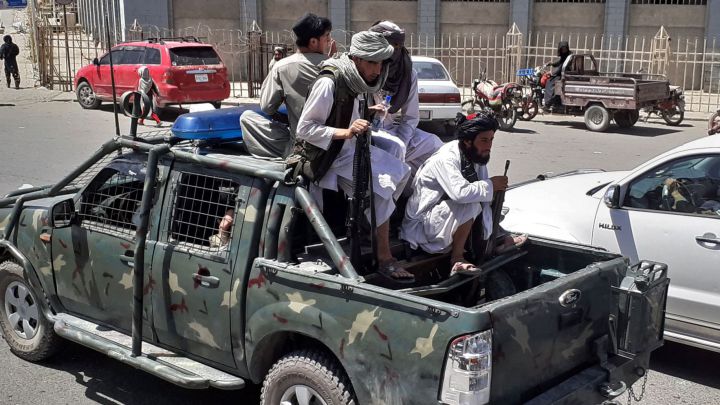The United States’ decades-long involvement in Afghanistan was sparked by the Taliban’s role in the 9/11 attacks, but who are the hardline militia group?
On Friday numerous agencies reported that the Taliban had captured Kandahar, the second-largest Afghan city, and was closing in the capital of Kabul. These advances mark the latest strategic attacks since the United States announced its withdrawal from the country earlier this year.
The militia group is now thought to control at least 14 of Afghanistan’s 34 provincial capitals with still more on the brink of falling due to ongoing fighting. The Taliban approaches Kabul with President Ashraf Ghani’s government looking increasingly vulnerable and they are attempting to displace him as the country’s leader.
The Taliban captured Afghanistan's 2nd and 3rd largest cities and now controls most of the country — including a city 50 miles from Kabul.
As the U.S. withdraws from its 20-year occupation, the Taliban has displaced almost 400,000 people, with 1,000+ civilians killed this month. pic.twitter.com/t5EVDn2lsg
— AJ+ (@ajplus) August 13, 2021
But who are the Taliban, and how have they grown to such prominence in Afghanistan’s social and political structures?
Origins and rise of the Taliban
The birth of the Taliban as an organised group came in the aftermath of another military withdrawal, when Soviet troops left Afghanistan in the early 1990s. The name ‘Taliban’ translates to ‘students’ in the Pashto language and followers are strict adherents to a form of Sunni Islam.
Throughout the 1990s they expanded their reach in south-western Afghanistan before overthrowing President Burhanuddin Rabbani in 1996 and claiming the capital of Kabul. By 1998, within a decade of its formation, the Taliban controlled roughly 90% of Afghanistan.
They earned support in certain communities for their tough interpretation of Sharia law, with public executions for murderers and adulterers. They brought with them a traditionalist view of society and introduced bans on television, music and cinema, while women were forced to wear the all-covering burka and girls were discouraged from going to school beyond the age of ten.
Taliban links to al-Qaeda
Despite their prominence in Afghan society it was not until 11 September 2001 that the Taliban really garnered the world’s attention, when they were accused of providing sanctuary for Osama Bin Laden and other al-Qaeda members in the aftermath of the terror attacks on the World Trade Center.
Less than a month after the attacks the United States led a military coalition into Afghanistan and brought about the collapse of the Taliban regime in early December. The group’s hierarchy scattered but, despite the ongoing presence of foreign forces in the country, managed to gradually regain their influence in Afghanistan.
‘Afghanistan is spinning out of control’ — UN Secretary-General António Guterres is calling on the Taliban to stop attacking civilians pic.twitter.com/3WzovQ4dKj
— NowThis (@nowthisnews) August 13, 2021
What followed was a period of instability in the region with neither side able to decisively gain the upper hand. The Taliban launched an attack on Nato’s Camp Bastion base in September 2012 and numerous bouts of violence in the city of Kabul allowed them to maintain a hold over Afghan society.
In May 2016 Taliban leader Mullah Mansour was killed in a US drone strike and was replaced by his former deputy, Mawlawi Hibatullah Akhundzada, who remains the group’s leader to this day.
Biden announces withdrawal after US-Taliban peace talks
In February 2020 the Taliban agreed a peace deal with the United States and moved away from the large-scale attacks on major cities which had characterised their rise to power nearly three decades earlier.
But despite forgoing the larger military operations, they became more focused on targeted attacks on journalists, politicians, activists and women in positions of power to enforce their extremist views through a strategy of more localised terrorism.
However without a constant military presence from the Taliban, new US President Joe Biden announced in April 2021 that he was ordering the withdrawal of all American forces from Afghanistan. The end date for their involvement on the ground was set at 11 September 2021, exactly two decades after the World Trade Center attacks.
Given the speed with which Afghanistan's government has fallen apart after the American withdrawal, maybe we should rethink our past actions as "running a client state" instead of fighting an ongoing war of support for a friendly but beleaguered government
— Patrick Wyman (@Patrick_Wyman) August 12, 2021
However when the US military began to withdraw earlier this year the Taliban quickly resumed their territory accumulation and are now doing so with a much larger force. Recent Nato estimates suggest that they currently have around 85,000 full time fighters at their disposal after consolidating in recent years, far more than any point since the US arrived in 2001.
On Friday the Pentagon said that they were “deeply concerned” about the Taliban’s advance through Afghanistan as their rapid surge towards Kabul continues. The Biden administration has greenlit the reintroduction of 3,000 troops to Kabul airport to assist with evacuation efforts, but has stopped short of cancelling the planned withdrawal.

